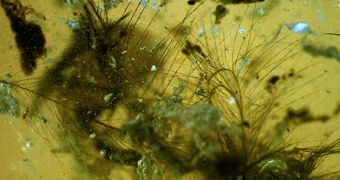We know that some carnivorous (theropod) dinosaurs were feathered. Archaeopteryx, the oldest bird-dinosaur fossil discovered, was feathered, too. But the fossils preserved only imprints of feathers, as the feathers themselves degrade in time.
However, this new discovery published in the journal "Proceedings of the Royal Society B" represents the oldest preserved feathers encountered so far: 7 feathers perfectly preserved in amber and being 100 million years old, from the Cretaceous, the last dinosaur era. The feathers have both feather-like fibers encountered in imprints of the feathers of some theropods and traits seen in bird feathers.
"This means the fossils could fill a key gap in the puzzle of how dinosaurs gave rise to birds," signaled the researchers led by Vincent Perrichot from the University of Kansas's Paleontological Institute, who cannot tell precisely whether the feathers belonged to a dinosaur or a bird.
This is a "passage between primitive filamentous down and a modern feather," said co-author Didier N?raudeau from the University of Rennes in France.
"But fossil teeth from two dino families thought to have been feathered were excavated from rocks just above the layer that contained the amber. It is entirely plausible that the feathers come from a dinosaur rather than from a bird," said Perrichot. The piece of amber was discovered in a quarry in the Poitou-Charentes (western France) in 2000.
"The feathers' central shafts, or rachis, are primitive and most closely resemble down feathers. The feather filaments, or barbs, had yet to become fully fused at the base and-like modern down-they lacked hooklets known as barbules to hold the filaments together. Today's birds could not fly with such feathers," wrote the authors.
Many researches point that primitive feathers appeared in flightless dinosaurs for achieving homeothermia (constant high body temperature), acting like insulation. The use of the feathers in order to fly appears to be a later achievement, that came like a bonus.
"The amber-encased feathers show for the first time the transition from downy filaments toward an aerodynamic, planar shape that enabled flight. This most critical step in the evolution of feathers was suggested by evolutionary theories but had never previously been seen in either modern or fossil feathers," said Perrichot.
"The newfound feathers are around 50 million years younger than the first known flying bird, Archaeopteryx, which lived about 150 million years ago. So the animal isn't transitional but it may preserve a transitional structure," Nick Longrich, a bird-fossil expert of the University of Calgary in Canada, wrote to National Geographic News.
"It's also possible that the simplified structure of the feathers isn't so primitive. Modern flightless birds such as ostriches and emus have highly simplified feathers. Hopefully this study will cause more people to look for dinosaur feathers in amber," added Longrich.

 14 DAY TRIAL //
14 DAY TRIAL //